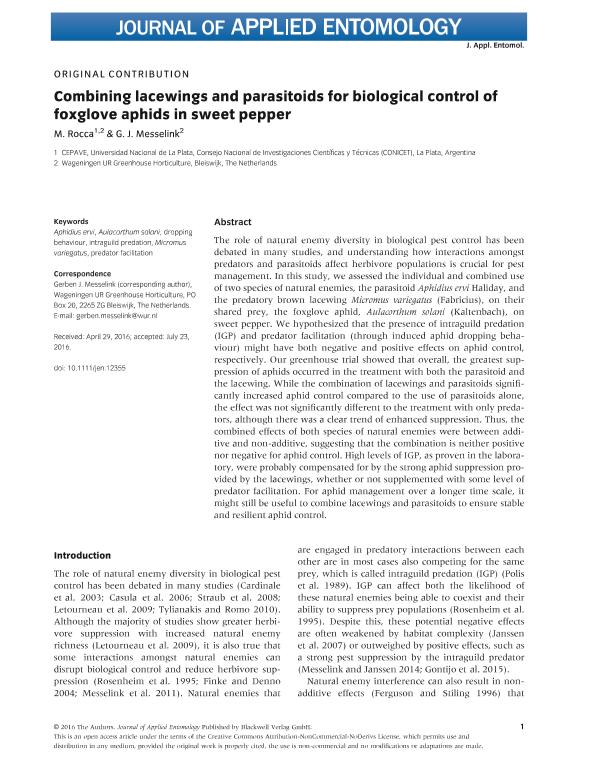Artículo
Combining lacewings and parasitoids for biological control of foxglove aphids in sweet pepper
Fecha de publicación:
06/2017
Editorial:
Wiley Blackwell Publishing, Inc
Revista:
Journal of Applied Entomology
ISSN:
0931-2048
Idioma:
Inglés
Tipo de recurso:
Artículo publicado
Clasificación temática:
Resumen
The role of natural enemy diversity in biological pest control has been debated in many studies, and understanding how interactions amongst predators and parasitoids affect herbivore populations is crucial for pest management. In this study, we assessed the individual and combined use of two species of natural enemies, the parasitoid Aphidius ervi Haliday, and the predatory brown lacewing Micromus variegatus (Fabricius), on their shared prey, the foxglove aphid, Aulacorthum solani (Kaltenbach), on sweet pepper. We hypothesized that the presence of intraguild predation (IGP) and predator facilitation (through induced aphid dropping behaviour) might have both negative and positive effects on aphid control, respectively. Our greenhouse trial showed that overall, the greatest suppression of aphids occurred in the treatment with both the parasitoid and the lacewing. While the combination of lacewings and parasitoids significantly increased aphid control compared to the use of parasitoids alone, the effect was not significantly different to the treatment with only predators, although there was a clear trend of enhanced suppression. Thus, the combined effects of both species of natural enemies were between additive and non-additive, suggesting that the combination is neither positive nor negative for aphid control. High levels of IGP, as proven in the laboratory, were probably compensated for by the strong aphid suppression provided by the lacewings, whether or not supplemented with some level of predator facilitation. For aphid management over a longer time scale, it might still be useful to combine lacewings and parasitoids to ensure stable and resilient aphid control.
Archivos asociados
Licencia
Identificadores
Colecciones
Articulos(CEPAVE)
Articulos de CENTRO DE EST.PARASITOL.Y DE VECTORES (I)
Articulos de CENTRO DE EST.PARASITOL.Y DE VECTORES (I)
Citación
Rocca, Margarita; Messelink, Gerben J.; Combining lacewings and parasitoids for biological control of foxglove aphids in sweet pepper; Wiley Blackwell Publishing, Inc; Journal of Applied Entomology; 141; 5; 6-2017; 402-410
Compartir
Altmétricas




